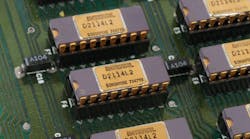Intersil, an analog chipmaker founded in the early days of the semiconductor industry, reinvents itself every few years.
The California-based company started out making chips for electronic watches. It expanded into power management chips for satellites and personal computers before going public in 2000. But following its I.P.O., the company struggled to match the money-making power of competitors like Linear Technology and Maxim Integrated.
Since 2013, Intersil has specialized in products that throttle the electricity flowing through cars and industrial equipment. The company was in the third year of a turnaround when it agreed on Tuesday to be purchased by Renesas in the industry’s latest round of matchmaking. Here’s how Intersil reached this point:
1967 Jean Hoerni, one of the founders of Fairchild Semiconductor and Union Carbide Electronics, who invented the planar process for manufacturing silicon transistors, founded Intersil – short for International Silicon – to make chips for watches and calculators.
1975 Intersil introduced the IM6100 microprocessor, one of the earliest built with CMOS circuitry instead of the NMOS technology favored by competitors. Its simple architecture and low power consumption made it a popular option for military equipment and early computers.
1980 General Electric absorbed Intersil into its semiconductor division.
1988 Harris, the communications equipment maker, acquired General Electric’s chip business, which had earned around $550 million the year before the deal. Harris merged the business with Radiation Corporation, the chipmaker it acquired in 1967 for making processors that could effectively shield radiation in satellite applications.
1999 Harris initiated a restructuring plan and sold its entire semiconductor business to an investment firm, which revived the Intersil brand. The new company took control of a chip fabrication plant in Melbourne, Florida. It employed around 1,400 people.
2000 Intersil joined the NASDAQ stock exchange. Buoyed by the dot-com bubble, the analog chipmaker raised $500 million in the biggest semiconductor I.P.O. in history.
2002 In its first major acquisition, Intersil signed a $1.4 billion deal to buy Elantec Semiconductor, a maker of optical devices like compact discs and displays. Intersil’s board appointed Richard Beyer, Elantec’s chief executive, as the new C.E.O.
2003 Intersil underlined its shift into analog and power management devices: It sold its wireless business and signed its first manufacturing deal with IBM. The company agreed to install fabrication equipment for power semiconductors into IBM’s Burlington, Vermont foundry.
2004 The company acquired Xicor, a maker of digital potentiometers and analog circuits that convert things like light and sound into digital form. Intersil paid $529 million in the deal. It was the company’s last acquisition for several years, before it expanded into a wide range of chips for digital power management and video processing.
2008 Richard Beyer resigned in order to take the job as Freescale’s C.E.O. David Bell, Intersil’s president and chief operating officer, succeeded him. Grappling with economic uncertainty, the company consolidated its Florida factories and announced that it was cutting 140 employees – around 9% of its workforce.
2009 and 2010 Following the acquisition of chipmakers like Kenet and Zilker Labs in 2008, Intersil plunged into a buying spree. In 2009, the company added Quellan and China’s Rock Semiconductor, which designed signal processing and power management chips, respectively. A year later, it signed a deal to acquire Techwell, a maker of mixed-signal chips for security cameras and automotive displays.
2012 Expanding so quickly took its toll. Intersil overextended itself and revenues plummeted. In 2012, the company generated only $607.9 million, which represented $152.6 million less than the company earned the previous year. David Bell resigned as president and C.E.O.
2013 Necip Sayiner, formerly the chief executive of Silicon Labs, took over as chief executive. By cutting costs and investing in product development, Intersil unexpectedly turned a profit. But it also cut 150 employees toward the end of the year, reducing its workforce to around a thousand people.
2014 Sayiner rebranded Intersil as a power management specialist and nudged the company out of the market for personal computers, which had begun to slow. Instead, he steered Intersil into the growing markets for automotive and industrial electronics. The new strategy enlarged profits, which reached $54.8 million, up from $2.9 million in 2013.
2015 A jury ruled that Intersil pay $58.8 million to Texas Advanced Optoelectronic Solutions for patent infringement. Intersil said it would seek to overturn the ruling through appeals to the United States Circuit Court of Appeals.
2016 After years of sluggish performance, Intersil’s share price jumped 44% after the revelation that Renesas was negotiating to buy the company. The rumors were confirmed when Intersil agreed to be bought by Renesas for $3.2 billion.

